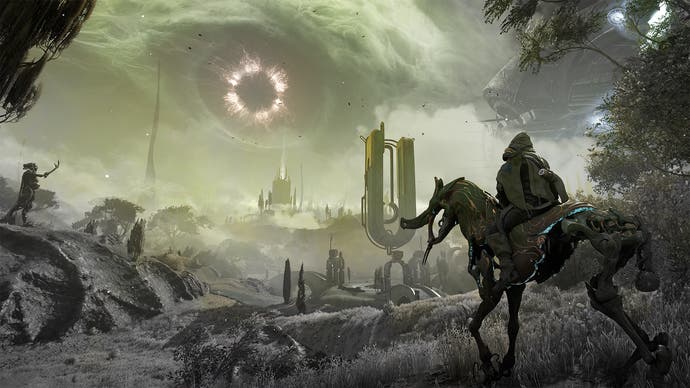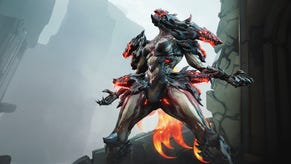Digital Extremes talks The Duviri Paradox - Warframe's weirdest expansion yet
As the fantasy western rogue-like arrives.
The Duviri Paradox, Warframe's latest expansion, is weird, quite unlike anything the free-to-play shooter has attempted before. It ditches the game's usually overt sci-fi trappings in favour of something closer to a fantasy western: it's in black and white (except when it isn't); it's a rogue-like; it's simultaneously both a sequel and a prequel (paradoxes, eh?), and the whole thing takes place inside the mind of its new Big Bad. Oh, and despite being radically different, it's also the new opening to the game. Like I said, The Duviri Paradox is weird.
So what, you might well ask, is going on here? "It's sort of the reality when... you've been making the same game for 10 years," Warframe's creative director Rebecca Ford tells me during a recent chat, "that if you keep piling things on at the end of the experience, you leave a lot of people behind... And we also realise the people who've been with us for 10 years, if we keep giving them exactly what they expect, eventually they'll lose interest.
"So we tried to converge the immense weight of veteran expectations with the grim reality of running a game as a service and people feeling it's too impenetrable. And we tried to force gravity to bend to our will and create this new beginning. Will it work? You tell us!"
And so, once The Duviri Paradox arrives later today, players who don't even know what a Warframe is will be able to dive straight into the expansion's weird, wonderful fantasy western world, embarking on an experience that, at first glance, might seem worlds apart from the harder sci-fi of Warframe's core. Here, trapped in the mind of the Mad King Dominus Thrax, they'll play as a Drifter, desperately trying to escape a never-ending cycle of death and rebirth. And it's there that The Duviri Paradox's hat tip to the roguelike genre starts to become apparent, eliciting the immediate question of why such a radical genre-swerve for the game?
"Because I like roguelites," Ford laughs, "and because Warframe is so big, so comprehensive in the risks it has taken, we felt we could do an update that [was both a] true Warframe update [and] a radical recontextualisation of Warframe's gameplay... The Duviri Paradox tries to take the things we love about rogue-lites and Warframe and throw them in a pot to see if we can make a soup. It's the soupiest update ever!" The result, as Ford puts it, is "probably the most aggressive we've gone for in theme and gameplay rules [and] without a doubt the most unique Warframe experience that you can play".
Given its prominent place at the very start of the Warframe experience as an optional new introduction to the game (existing players can also access it via the system map), The Duviri Paradox's opening quest serves as something of a revitalised tutorial and more accessible entry point for the notoriously impenetrable live-service game. Not only does it ambitiously navigate introductions to both new and existing mechanics, it also has the task of juggling its dual universes, one all baroque sci-fi epic and the other a constantly fluctuating representation of its host's ever-changing moods.

"I think for us, when we were picking where to put it," Ford explains of The Duviri's Paradox unconventional placement in the game, "the reality is, if you play through the existing new player experience and then all of a sudden you're playing the Duviri Paradox and getting a different set of moves, different gameplay... it might be weird... So why not just bring the change in the most radical way we can? Let players pick right off the hop, make it seamless so they can go back and forth once they're done with the story - they're never roadblocked by understanding a mechanic because it's just always there.
"And for me, it was if we're gonna go big, go radical, don't force a path that might have been a natural choice a player would have wanted to make... And the way we've presented this choice just feels like it's a very intentional part of the narrative now, which I think sets Warframe apart from a lot of other games, because the narrative is now leaning into a very mechanic-heavy choice that's actually the truest flavour we've ever given. So I'm very, very happy with the way it's presented."
Most of The Duviri Paradox's tutorialising occurs within its opening six-chapter quest, a 90-minute cinematic experience Ford joking refers to as a story about "managing emotions and owning an apartment", given it's thematic touchstones. It's an adventure that'll take players across the striking open-world of Duviri - where they'll be able to deploy their new Drifter melee abilities or ride atop their wonderful new mechanical steed - and down to the murky Undercroft, using Warframes to compete in more traditional missions that reward the likes of Decrees. These temporary, session-specific ability upgrades are one of two new ways Drifters can improve their skills throughout The Duviri Paradox, the other being permanent Drifter Intrinsics, unlocking melee stances and the likes of combat and riding upgrades.
 Warframe | The Duviri Paradox - Visions of Duviri Official Trailer - Available Now On All Platforms!
Warframe | The Duviri Paradox - Visions of Duviri Official Trailer - Available Now On All Platforms!
So yes, it's all very different to the "classic" Warframe experience, and as Ford explains it, there's a careful balancing act going on to ensure The Duviri Paradox still exists comfortably within the core Warframe world. "I think the key part of what makes it Warframe is how we punctuate the story for every Duviri Paradox encounter with the most important choice: what Warframe are you going to play? So you can imagine the full story of Duviri is: you're making your Warframe choice, you're entering the world as the Drifter, the world is black and white and you need to earn enough change to get the Warframe to arrive [from the other side]... and then by the end of the day, the Drifter has made peace with the [world's current emotion] and the Warframe says, 'See ya.'"
And, of course, once the introductory quest is over, players can use their newfound Drifter skills and abilities to explore Duviri's open-world proper. At this point, new players have the option to stay and push forward using loaner Warframes or make the leap to the other side of the game and begin that core journey of acquiring their own. Either way, the full, fully co-operative Duviri experience features over 50 side activities - including the familiar likes of fishing and resources gathering - all at the mercy of Dominus Thrax's five world-shaping "mood spirals" - Fear, Envy, Anger, Sorrow, and Joy.
Each of these, switching over every two hours, radically alters Duviri's atmosphere, visuals, and enemies, including its "high-scale" mood-specific bosses, known as Orowyrms - said to be some of Warframe's most ambitious confrontations yet. Luciana, the sorrow zone boss, for instance, attacks across two phases, the first a land-based battle and the second taking place down in the Undercroft, where it entwines a huge arena, hurling out ice attacks. Grinding these bosses for rewards forms one chunk of Duviri's repeatable play, and there's also a new "endless" mode known as The Circuit, challenging Tenno to battle through an ever-changing mix of familiar Mission types to unlock Decrees and push just that little bit further each time.
It is, then, a lot - and that's not even touching on things like the new cosmetics options, including a dazzling array of beard options for Drifters, I'm told - and I can't help wonder if the development of The Duviri Paradox has been an emboldening experience for the team in the way it considers what Warframe can be? "It has but not in the way you think," Ford tells me enigmatically. "And I would recommend you watch TennoCon this year; we actually do have a new destination we're going to and it will surely shock and surprise everyone... the next step for us in terms of genre crossover." And is the extremely weird Duviri Paradox indicative of the kind of bigger risks we can expect from Warframe in the future? "Oh yes", Ford smiles.
Warframe's The Duviri Paradox expansion launches today on Xbox, PlayStation, Switch, and PC.









